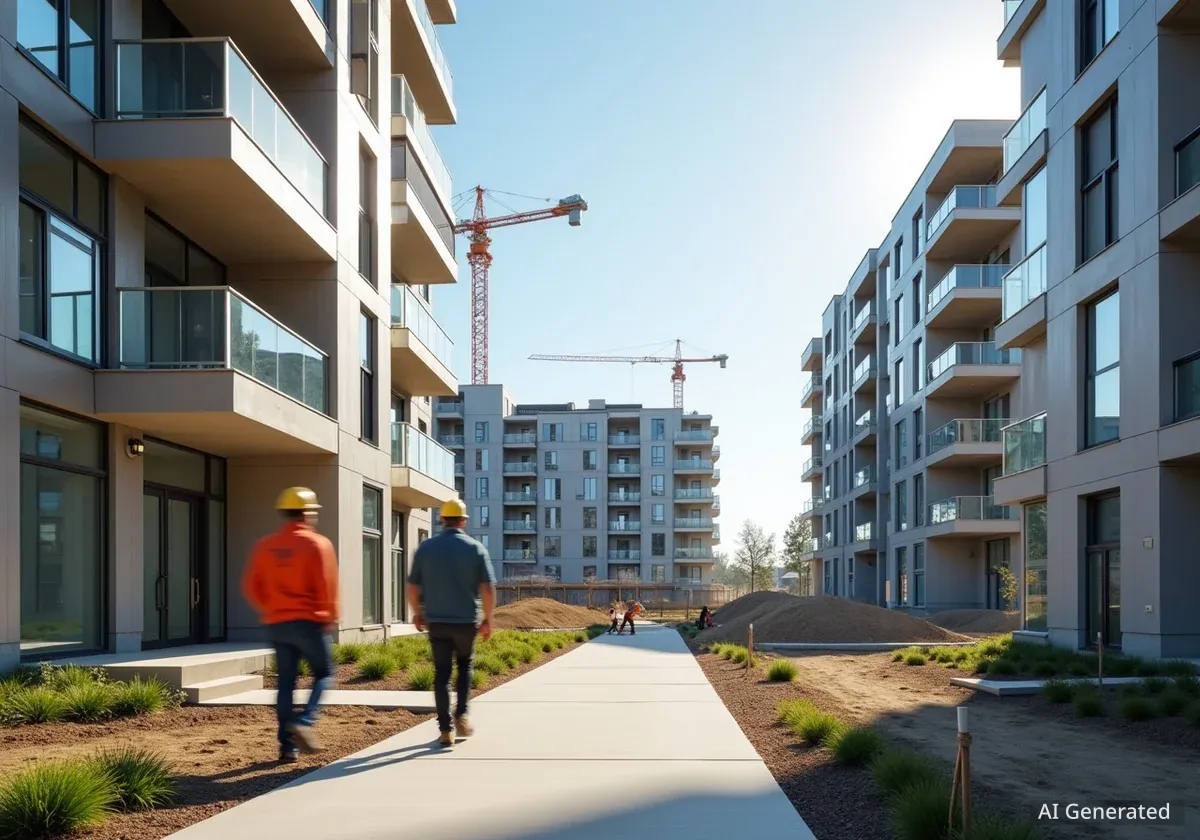Chinese officials have reported significant progress in the nation's housing and construction sectors during the 14th Five-Year Plan period, which spans from 2021 to 2025. At a press conference held by the State Council Information Office, details were provided on the construction of affordable housing, urban renewal projects, and the overall growth of the construction industry.
According to Minister of Housing and Urban-Rural Development Ni Hong and other officials, these efforts have focused on meeting diverse housing demands, stabilizing the real estate market, and improving living conditions for millions of residents across the country.
Key Takeaways
- Over 11 million units of affordable and resettlement housing have been constructed since 2021, benefiting more than 30 million residents.
- China's construction industry output reached 32.7 trillion yuan ($4.6 trillion) in 2024, a 24% increase from 2020.
- More than 240,000 aging residential communities have been renovated, improving living conditions for over 40 million households.
- A campaign to complete stalled real estate projects has resulted in the delivery of over 7.5 million previously delayed housing units.
A Focus on Affordable Housing
A central component of China's strategy has been the expansion of its housing security system. Vice Minister Dong Jianguo explained that the government has worked to build a multi-tiered system to cater to different groups, including new city dwellers and young people.
Since 2021, a major push in affordable housing has yielded tangible results. The construction of more than 11 million units of affordable and resettlement housing has been completed. This figure includes projects aimed at redeveloping "urban villages" and replacing dilapidated residential areas.
These initiatives have directly impacted the lives of over 30 million residents, providing them with improved and more secure living arrangements. The government's goal, as stated by officials, is to ensure basic housing needs are met for a wide segment of the population.
Housing by the Numbers
- 11 million+ affordable housing units built (2021-2025 period).
- 30 million+ residents benefited from these new homes.
- 7.5 million+ stalled housing units have been completed and delivered.
Stabilizing the Real Estate Market
In recent years, the Chinese government has implemented a series of measures to foster a stable and healthy property market. Minister Ni Hong emphasized the goal of meeting not only basic housing needs but also the public's growing desire for better living conditions.
Local governments have been granted the flexibility to adopt differentiated real estate policies tailored to their specific conditions. This has led to adjustments in down payment ratios and mortgage rates to support home purchases. Additionally, tax rebates have been offered for homeowners upgrading their properties, a policy described as "sell-to-buy."
A New Development Model
Officials stated that China is accelerating the development of a new model for its real estate sector. This model focuses on reforming financing and sales mechanisms, improving the housing supply system, and promoting the construction of high-quality homes that are safe, green, and technologically advanced.
During the 2021-2025 period, new commercial housing sales accounted for approximately 5 billion square meters of floor space. The market for existing homes has also seen rapid growth. In 15 provincial regions, transactions of second-hand homes now outnumber sales of new properties, indicating a maturing market.
Addressing Project Delays
To mitigate risks associated with stalled real estate projects, a nationwide campaign was launched to ensure pre-sold homes are delivered on time. Vice Minister Dong Jianguo confirmed the success of this initiative.
"So far, more than 7.5 million previously delayed units have been completed and delivered, effectively safeguarding homebuyers' legitimate rights and interests," Dong stated at the press conference.
This program has been critical in restoring consumer confidence and protecting the investments of ordinary citizens.
Extensive Urban Renewal Projects
Beyond the construction of new homes, China has invested heavily in urban renewal to improve existing infrastructure and community facilities. Since 2021, these efforts have transformed aging urban areas.
According to the ministry, more than 240,000 aging residential communities have undergone renovation. This sweeping initiative has benefited over 40 million households, which translates to approximately 110 million people.
The upgrades have been comprehensive and aimed at improving daily life:
- Elevators: 129,000 new elevators were installed in older residential buildings.
- Parking: Over 3.4 million new parking spaces were created to address shortages.
- Community Services: 64,000 new community facilities were built, including centers for elderly care and childcare.
Infrastructure renewal has also been a priority. Officials reported that 840,000 kilometers of underground pipelines for water, gas, and heating have been updated. Furthermore, urban green spaces have been expanded with the creation of over 18,000 "pocket parks" and 25,000 kilometers of urban greenways.
Growth of the Construction Industry
The policies supporting housing and urban renewal have contributed to the steady expansion of China's construction industry. Vice Minister Li Xiaolong provided data highlighting the sector's significant growth.
In 2024, the total output of the construction industry reached 32.7 trillion yuan ($4.6 trillion). This represents a 24% increase compared to the output in 2020. This growth reflects a massive scale of building activity across the country.
Infrastructure Development (2021-2024)
- New Building Area: 15.4 billion square meters completed.
- Municipal Roads: 79,000 kilometers constructed.
- Urban Rail Transit: 3,429 kilometers added.
- Railways: 16,000 kilometers built.
- Highways: 290,000 kilometers constructed.
The influence of Chinese construction firms has also grown on the global stage. From 2021 to 2024, these enterprises signed over $1 trillion in overseas engineering contracts, which generated $640 billion in revenue.
Li noted that in 2025, 76 companies from the Chinese mainland were featured among the world's top 250 international contractors. Of these, four were ranked in the top ten, underscoring their significant international presence and capabilities.





